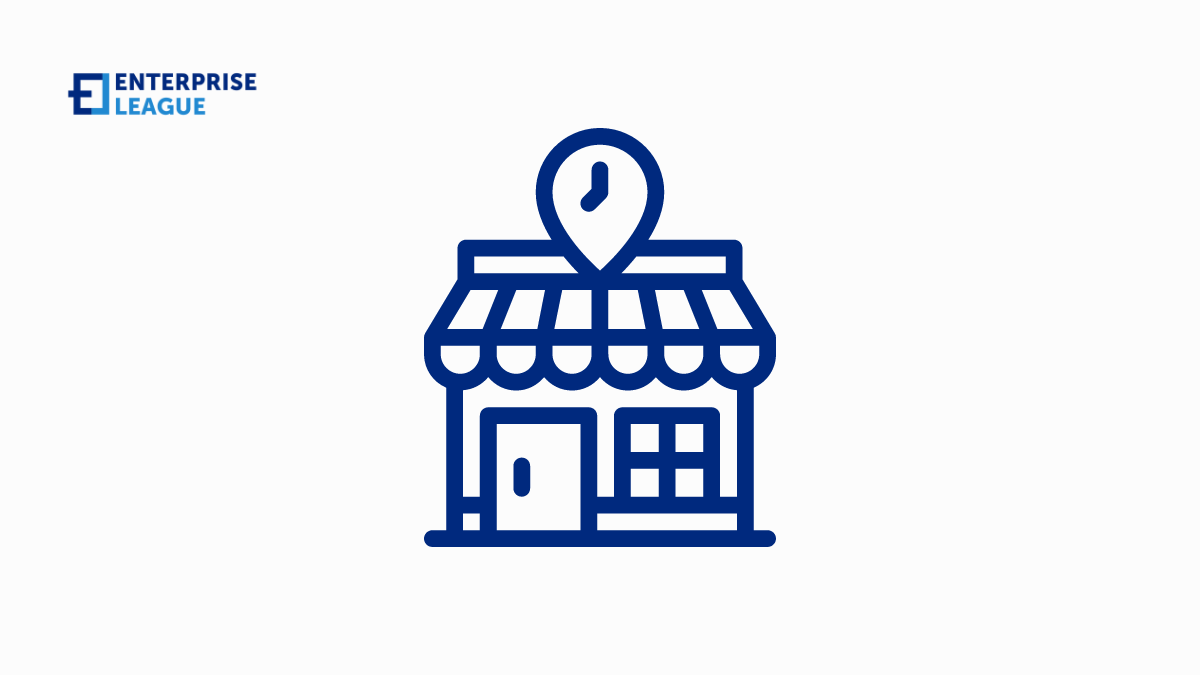Remember those cute and eye-catching stores that suddenly out of nowhere appear in your town and after a few days, they are gone? Well, those are called pop-up shops and usually they’re set up in a temporary location which, to be honest, temporary location is a great way to explore busy shopping districts and present your products to new customers. With a global pop-up market that is projected to reach an estimated $15.6bn in 2026, seems like the right timing to unveil and explore some pop-up business ideas that will bring you profit while allowing you to explore diverse locations and people.
Top 19 pop-up business ideas
For starters, we’ve made a list of the most trending and profitable pop-up business ideas that are quite easy to start without investing too much.
Clothing pop-up shops
Clothing pop-up shops a short-term sales events where fashion retailers temporarily open physical stores to showcase current seasonal collections. The element of exclusivity in timing and location builds buyer urgency that amplifies sales versus year-round shops. Pop-ups also enable customers to tactically browse trending styles curated in digestible store concepts versus vast department aisles.
For clothing brands, traveling pop-ups reach audiences far beyond existing boutique locations for targeted product feedback. Savvy digital marketing builds local hype around the limited days for consumers to visit and directly see, touch, and fit emerging fashion lines. Placed inside complementary venues like artisan markets or at high commuter transit points, the transient physical store ultimately complements modern omnichannel retail. The experiential sale delivers both revenue spikes and lasting brand familiarity that persists digitally until the next pop-up appears.
How much you can make: $20,000 – $200,000 annually
How much does it cost to start: $5,000 – $50,000
How long does it take to build: 1-3 months
Holiday shops
A holiday shop business would involve selling holiday-themed merchandise in retail stores. This could be an appealing business idea because holidays lead to increased consumer spending on gifts, decorations, food, and more. A holiday shop chain can take advantage of this seasonal uptick in spending by offering specialized inventory tailored to various holidays year-round.
As each holiday approaches, the store brings the relevant products to the forefront. Carrying a wide selection of holiday merchandise allows the business to drive repeat traffic, capture more holiday spending from customers, and build a destination retail brand with expertise in holiday goods.
How much you can make: $20,000-$100,000/season
How much does it cost to start: $5,000-$20,000
How long does it take to build: 1-2 months
Customized product shops
It is a retail business that offers customers the ability to personalize the products they purchase. This lets the customer put their creative touch on items, making them more unique and meaningful. The shop would utilize technology to give people options to customize products like clothing, drinkware, home goods, accessories, and more. Customers could select colors, materials, embroider words or images, and make other modifications so the end result is a one-of-a-kind item just for them.
This is an appealing business idea because personalized items are popular, as people enjoy things made specifically to match their style and preferences. The customization process itself can be fun and rewarding for shoppers. Additionally, customized products tend to command higher prices than generic mass-produced items, so profit margins could be favorable. The ability to offer specialty creations tailored to individuals gives this retail store concept an advantage in the marketplace.
How much you can make: $50,000-$200,000/year
How much does it cost to start: $10,000-$50,000
How long does it take to build: 1-3 months
Seasonal must-haves shops
Seasonal must-haves shops center around brick-and-mortar shops selling popular items tied to seasonal events or holidays. These shops would carry merchandise tailored to the season or upcoming holiday. For example, around Halloween, a shop may sell costumes and decorations, while holiday season shops would offer festive decor, advent calendars, etc.
This concept helps meet predictable seasonal shopping demand in a retail environment focused on relevant products. Creating stores with specialty offerings can attract interest from shoppers seeking specific items for seasonal or holiday celebrations. Since these occasions bring increased consumer spending, seasonal shops allow conveniently tapping into related shopping habits in a niche format.
How much you can make: $20,000-$100,000/season
How much does it cost to start: $5,000-$20,000
How long does it take to build: 1-2 months
Themed pop-up cafes
Themed pop-up cafes are temporary cafes that offer a novel experience around a specific theme that rotates periodically. This can be an engaging business idea because it allows the opportunity to attract customer interest through the allure of ‘limited time only’ establishments, while regularly changing the theme to keep things fresh and different. Pop-up cafes also enable testing unique concepts without the commitment of long-term leases or significant upfront investment that permanent locations require.
As customers seek memorable experiences, themed cafes can deliver share-worthy moments. Additionally, they can effectively generate buzz on social media when executed thoughtfully. If timed strategically around holidays, events, or cultural moments, themed pop-up cafes can capitalize on heightened consumer spending during specific occasions.
How much you can make: $50,000-$200,000/year
How much does it cost to start: $20,000-$50,000
How long does it take to build: 2-4 months
Pop-up bookstores
A pop-up bookstore is a temporary bookstore that opens for a short period of time, often just a few days or weeks, in a space not originally designed for retail. This allows an entrepreneur to sell books, host events, and build community without taking on the overhead of a permanent storefront. Pop-up bookstores can thrive by capitalizing on the novelty, bringing literary events to new spaces, and fostering connections among local readers and authors.
The ephemeral nature keeps operating costs low. In addition, the impermanent locales—be they empty storefronts, community centers, or outdoor markets—give exposure to potential new neighborhoods of book buyers. Though intensively coordinated, pop-up bookstores provide a creative way for book lovers to share their passion while testing retail concepts. With careful planning and marketing, they can attract crowds, energize communities, and potentially pave the way for a permanent shop.
How much you can make: $30,000-$100,000/year
How much does it cost to start: $10,000-$30,000
How long does it take to build: 1-2 months
Vintage clothing store
A vintage clothing store sells previously worn, retro, or antique clothing and accessories. This can be a promising business idea because vintage styles are often revived and popular again. There is demand for unique vintage pieces that shoppers cannot find at typical clothing retailers. A vintage shop offers customers one-of-a-kind, special garments and helps preserve quality clothing that might otherwise go to waste.
Generally speaking, the store would obtain vintage inventory from various sources and then sell the curated pieces in-store and potentially online. Vintage shops can build a following among fashion-forward customers seeking unusual, nostalgic, and environmentally friendly clothing finds. If well-executed with careful product procurement and marketing, a vintage shop can differentiate itself and thrive serving vintage enthusiasts and lovers of old-school style.
How much you can make: $50,000-$200,000/year
How much does it cost to start: $20,000-$50,000
How long does it take to build: 2-4 months
DIY workshop spaces
DIY workshop spaces revolve around providing a dedicated space for individuals to work on their personal projects, hobbies, or crafts. It offers a well-equipped facility with various tools, machinery, and resources that cater to different creative endeavors. This concept is attractive because it eliminates the need for people to invest in expensive equipment or struggle with limited space at home.
By offering a convenient and affordable solution, DIY Workshop Spaces empowers individuals to pursue their passions and bring their ideas to life. Moreover, it fosters a sense of community by bringing together like-minded individuals who can collaborate, share knowledge, and inspire each other. The business model is scalable and can be adapted to different locations and target markets, making it a versatile entrepreneurial opportunity. Overall, DIY Workshop Spaces has the potential to fill a gap in the market by providing a valuable service that enables people to unleash their creativity and turn their dreams into reality.
How much you can make: $30,000-$100,000/year
How much does it cost to start: $10,000-$30,000
How long does it take to build: 1-3 months
Tech gadget pop-ups
Tech gadget pop-ups set up temporary retail spaces to showcase and sell the latest tech gadgets. This allows customers to experience new innovative products in person before buying. Pop-up locations can be set up quickly and moved around, requiring less overhead than permanent retail spaces.
This mobility makes it easy to target events or areas with high foot traffic. The temporary nature also builds excitement and urgency to purchase. Curating interesting and useful gadgets in a fun, interactive retail setting provides value to tech-savvy consumers. The low operating costs and high customer engagement of a tech gadget pop-up have the ingredients to be a potentially lucrative business model.
How much you can make: $50,000-$200,000/year
How much does it cost to start: $20,000-$50,000
How long does it take to build: 1-3 months
Pop-up entertainment
Pop-up entertainment sets up temporary venues for events like parties, concerts, theater shows, comedy acts, magic shows, dances, and other social gatherings. This can be a promising business venture because entertainment is always in demand, and the pop-up model allows flexibility to hold events in different locations without the overhead of permanent real estate. It enables tapping into the excitement and novelty people often seek in their leisure pursuits.
The business can contract different performers and productions as needed for events tailored to client’s preferences. If executed strategically while building a loyal customer base, this concept has the potential to generate substantial revenue relative to the variable costs of setting up and running intermittent events.
How much you can make: $30,000-$100,000/year
How much does it cost to start: $10,000-$30,000
How long does it take to build: 1-2 months
Health and superfoods kiosk
Health and superfoods kiosk is a retail kiosk that sells healthy snacks and superfoods. This can be a good business idea because many people want convenient access to nutritious foods. The kiosk would offer grab-and-go items like protein bars, dried fruits and nuts, fresh fruit cups, nut butter, and similar foods made from nutrient-dense whole ingredients. A kiosk offers the advantage of low overhead costs compared to a traditional storefront. Product margins can be favorable since these types of snacks sell at a premium price point.
The kiosk brings this in-demand product category to high-foot-traffic areas like malls, offices, and transportation hubs. This helps busy professionals and health-focused consumers get quality snacks easily. They no longer need to go out of their way to find better-for-you food options. The kiosk model provides easy access right where people already are.
How much you can make: $50,000-$200,000/year
How much does it cost to start: $20,000-$50,000
How long does it take to build: 2-4 months
Mobile photography studio
A mobile photography studio is a business that brings a professional photography studio to clients’ preferred locations. It eliminates the typical constraints of an in-studio photo shoot and allows capturing moments in meaningful places for clients. The mobile equipment, including backdrops, lighting, cameras, and props, could be transported in a vehicle to any indoor or outdoor site within reason.
Operating this type of flexible and convenient boutique photography business allows for serving more clients in less time while also saving them travel efforts. As long as there is sufficient demand for on-location professional photography services in the target market area, this business idea could prove successful and worthwhile. The mobility and customization of the overall photography experience are major advantages.
How much you can make: $30,000-$100,000/year
How much does it cost to start: $10,000-$30,000
How long does it take to build: 1-2 months
Ethnic cuisine nights
Ethnic cuisine nights entail hosting nights where people can come to learn about and sample cuisine from different ethnicities or regions of the world. It would work by having a different ethnicity or region highlighted each night. For example, one night could feature Italian food and culture. Attendees would get to taste various popular Italian dishes while also learning about Italy through decorations, music, or even a guest speaker.
Other nights could highlight Mexican, Greek, Moroccan, or other global cuisines. This is an appealing business idea because food is popular and fun while also being an easy, interactive way for people to expand their cultural understanding. The variety of options allows for broad audience appeal across multiple events.
How much you can make: $30,000-$100,000/year
How much does it cost to start: $10,000-$30,000
How long does it take to build: 1-2 months
Temporary art galleries
Temporary art galleries set up temporary art galleries or exhibits in vacant retail spaces, event venues, or other available locations. This allows artists to showcase their work without needing to rent a permanent physical gallery. Pop-up galleries can provide affordable exposure for local artists while also activating unused spaces. They may collaborate with property managers to use vacant storefronts or warehouses on a short-term basis, bringing in artwork and event programming. It benefits artists seeking to gain an audience and buyers in the community. As well, it gives property owners a way to utilize empty spaces.
The business would coordinate these temporary galleries, handle logistics like lighting and displays, promote the events, and facilitate any sales. The flexibility and novelty of pop-up art exhibits can attract attention and visitors. By using available spaces for a period of time, the overhead is lower compared to a fixed gallery.
How much you can make: $20,000-$100,000/year
How much does it cost to start: $5,000-$20,000
How long does it take to build: 1-2 months
Children’s pop-up play zones
Children’s pop-up play zones are mobile pop-up play spaces for children that can be set up temporarily in various locations. This is a good business idea because it provides fun, engaging physical activity for kids without families needing to travel to a permanent playground or indoor play center. Pop-up play zones bring the play area right into neighborhoods, community events, or other spots closer to families. They offer movement, interactive games, and physical challenges suitable for young kids. As a temporary installation, the play zones can serve communities on a rotating schedule.
How much you can make: $30,000-$100,000/year
How much does it cost to start: 10,000-$30,000
How long does it take to build: 1-2 months
Local produce stand
A local produce stand is a straightforward yet profitable business concept. The core idea is to sell fresh fruits, vegetables, and other farm goods directly to customers in one’s community. This is an appealing opportunity because there is ongoing consumer demand for healthy, local food options. A produce stand makes it convenient for people to purchase nutritious ingredients while supporting nearby growers.
Additionally, the overhead costs of running an outdoor stand are relatively low compared to other food retail models. By offering an accessible platform for connecting consumers and producers, a local stand serves the community. With minimal barriers to launch, it enables entrepreneurial-minded individuals to fill a niche role.
How much you can make: $20,000-$100,000/year
How much does it cost to start: $5,000-$20,000
How long does it take to build: 1-2 months
Pop-up breakfast bar
A pop-up breakfast bar aims to provide quick, convenient breakfast fare to people on the go. The idea is to set up a small kiosk or cart in high-traffic areas in the morning hours where many folks are commuting to school or work. It would offer grab-and-go breakfast sandwiches, burritos, oatmeal cups, coffee, juice, and other simple but nutritious morning items.
This represents an opportunity to capture a share of the huge breakfast market by making the experience fast and hassle-free for busy customers. The relatively low overhead of renting space and operating a small cart versus a full restaurant or cafe allows for potentially attractive profit margins. Because it is mobile, the breakfast bar could shift locations over time and has flexibility if one area does not pan out as well as expected.
How much you can make: $30,000-$100,000/year
How much does it cost to start: $10,000-$30,000
How long does it take to build: 1-2 months
Handmade jewelry and accessories
Handmade jewelry and accessories involve designing, creating, and selling handmade jewelry and fashion accessories. There is demand for specialty jewelry and accessories that customers cannot find anywhere else.
Starting this business would require obtaining materials and tools for crafting jewelry, as well as skills in jewelry-making techniques. Promoting custom pieces on social media platforms, at craft fairs and markets, and through an online store could help connect with target customers. As it grows, the business could support hiring employees and expanding product lines.
How much you can make: $20,000-$100,000/year
How much does it cost to start: $5,000-$20,000
How long does it take to build: 1-3 months
Second-hand book swap/shop
Second-hand book swap/shop provides a location or service for people to buy, sell, trade, and swap used books. It could be a good opportunity because books can be resold or swapped many times as different readers enjoy them. An individual could open a physical retail shop focused on used books, which allows local readers to easily trade in and browse for pre-owned, gently used titles spanning many genres and subjects.
Another option is an online platform that connects buyers and sellers to exchange their old books and find new reads. This concept supports the local community, and sustainability through reusing/recircling, the availability of affordable books, and a shared love of reading.
How much you can make: $20,000-$100,000/year
How much does it cost to start: $5,000-$20,000
How long does it take to build: 1-2 months
Conclusion
Either you’re a talented chef or someone with a unique concept and ideas, don’t let the fear of failure hold you back. We can assure you that the the temporary nature of pop-ups provides an excellent opportunity to explore your ideas while minimizing risk.
More must-read stories from Enterprise League:
- Creative and profitable dog business ideas for dog lovers.
- Creative couple business ideas you should be aware of.
- Low-cost business ideas with huge potential.
- Get inspired from this list of creative craft business ideas.
- Smart nursing business ideas to keep an eye on.
Related Articles
Workplace Violence or Drug Accusations: Protecting Yourself Legally
Accusations of workplace violence or drug-related misconduct can derail a career, even when the claims are unfounded. A single allegation can lead to suspension, internal investigations, damaged professional relationships, and in serious cases, criminal charges....
Workers’ Compensation Costs for Factory and Warehouse Forklift Accidents
Forklifts play a central role in day-to-day operations across factories and warehouses, but they also create a significant risk of injury. When a forklift overturns, strikes a pedestrian, or drops a load, the financial impact reaches far beyond the immediate medical...
Delayed Construction Injury Reports: Impact on Workers’ Comp
Construction work carries unavoidable risks, which is why workers' compensation exists to protect employees after an injury. But one factor can alter the entire outcome of a claim: delayed reporting. In the construction industry, where injuries often occur in...
Workplace Violence or Drug Accusations: Protecting Yourself Legally
Accusations of workplace violence or drug-related misconduct can derail a career, even when the claims are unfounded. A single allegation can lead to suspension, internal investigations, damaged professional relationships, and in serious cases, criminal charges....
Workers’ Compensation Costs for Factory and Warehouse Forklift Accidents
Forklifts play a central role in day-to-day operations across factories and warehouses, but they also create a significant risk of injury. When a forklift overturns, strikes a pedestrian, or drops a load, the financial impact reaches far beyond the immediate medical...






